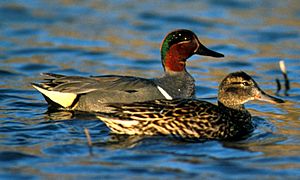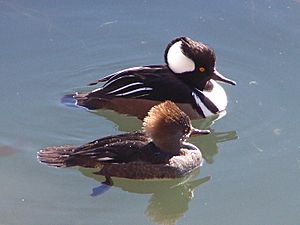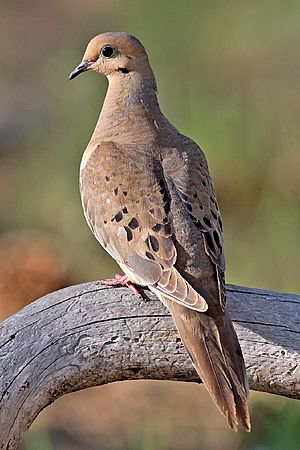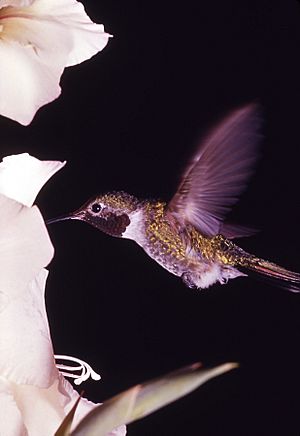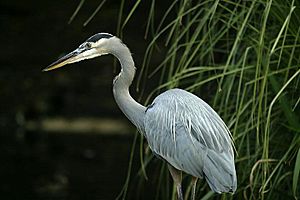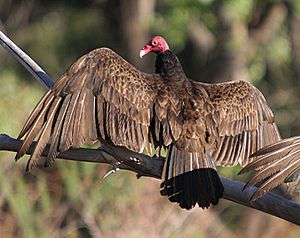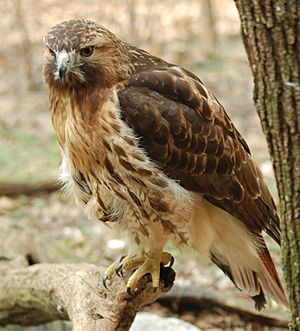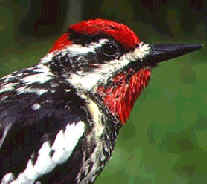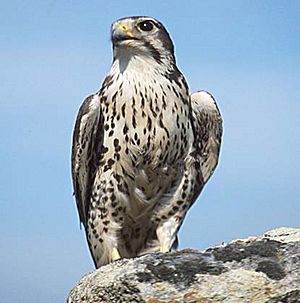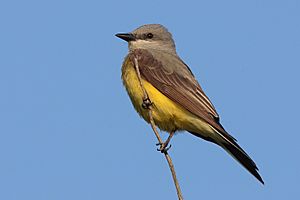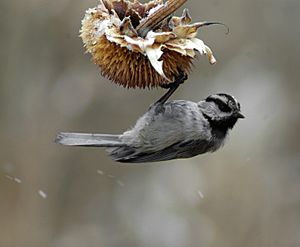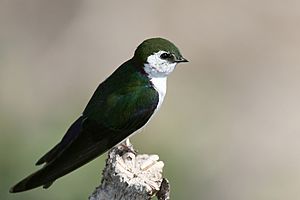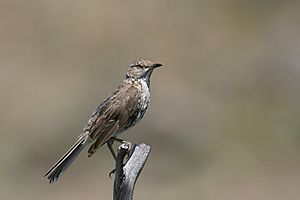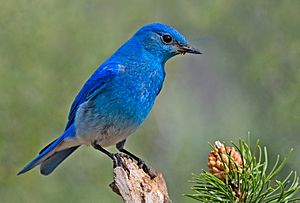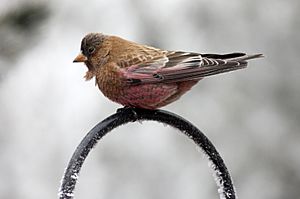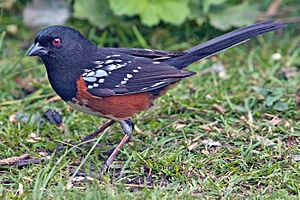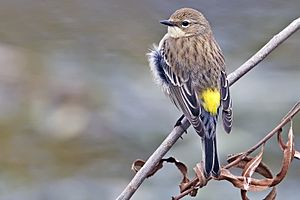List of birds of Black Canyon of the Gunnison National Park facts for kids
This page lists all the different kinds of birds found in Black Canyon of the Gunnison National Park in Colorado. The park is a special place in the United States. This list comes from the National Park Service (NPS). It includes 174 different bird species!
Birds on this list are grouped by their scientific families. This helps scientists keep track of them. The names come from the American Ornithological Society (AOS). Family names are from the Clements taxonomy.
Some birds have special notes next to their names. Here's what they mean:
- (PP) = Probably present: These birds are very likely in the park. But scientists need more proof. (31 species)
- (R) = Rare: You might only see these birds a few times each year. (38 species)
- (O) = Occasional: These birds show up every few years. Their numbers can change. (11 species)
- (Unk) = Unknown: Scientists don't know how many of these birds are in the park. (2 species)
- (I) = Introduced: Humans brought these birds to North America. They are not native. (5 species)
Other birds on the list are either always in the park (residents), visit during certain seasons, or pass through during migration. You can expect to see them at the right time of year.
Contents
- Ducks, Geese, and Waterfowl
- New World Quail
- Pheasants, Grouse, and Allies
- Grebes
- Pigeons and Doves
- Nightjars and Allies
- Hummingbirds
- Rails, Gallinules, and Coots
- Cranes
- Plovers and Lapwings
- Sandpipers and Allies
- Gulls, Terns, and Skimmers
- Herons, Egrets, and Bitterns
- New World Vultures
- Osprey
- Hawks, Eagles, and Kites
- Barn-Owls
- Owls
- Kingfishers
- Woodpeckers
- Falcons and Caracaras
- Tyrant Flycatchers
- Vireos and Allies
- Shrikes
- Crows, Jays, and Magpies
- Tits, Chickadees, and Titmice
- Larks
- Swallows
- Long-tailed Tits
- Kinglets
- Waxwings
- Nuthatches
- Treecreepers
- Gnatcatchers
- Wrens
- Mockingbirds and Thrashers
- Starlings
- Dippers
- Thrushes and Allies
- Old World Sparrows
- Wagtails and Pipits
- Finches, Euphonias, and Allies
- New World Sparrows
- Yellow-breasted Chat
- Troupials and Allies
- New World Warblers
- Cardinals and Allies
- More About Birds
Ducks, Geese, and Waterfowl
Order: Anseriformes Family: Anatidae
This group includes ducks, geese, and swans. These birds are great in water. They have webbed feet and special feathers. These feathers shed water easily because of natural oils.
- Canada goose, Branta canadensis
- Blue-winged teal, Spatula discors (PP)
- Cinnamon teal, Spatula cyanoptera (PP)
- Northern shoveler, Spatula clypeata (PP)
- Gadwall, Mareca strepera (PP)
- American wigeon, Mareca americana
- Mallard, Anas platyrhynchos
- Northern pintail, Anas acuta (PP)
- Green-winged teal, Anas crecca (PP)
- Redhead, Aythya americana (PP)
- Lesser scaup, Aythya affinis (PP)
- Common goldeneye, Bucephala clangula
- Barrow's goldeneye, Bucephala islandica (O)
- Hooded merganser, Lophodytes cucullatus (O)
- Common merganser, Mergus merganser
- Ruddy duck, Oxyura jamaicensis (PP)
New World Quail
Order: Galliformes Family: Odontophoridae
New World quails are small, round birds that live on the ground. They look like quails from other parts of the world. But they are not closely related.
- Gambel's quail, Callipepla gambelii (PP)
Pheasants, Grouse, and Allies
Order: Galliformes Family: Phasianidae
This family includes pheasants and their relatives. They are ground birds. They can be different sizes. But they are usually plump with wide, short wings. Many are hunted for sport or raised for food.
- Wild turkey, Meleagallopavo (O)
- Gunnison sage-grouse, Centrocercus minimus (R)
- Dusky grouse, Dendragapus obscurus
- Sharp-tailed grouse, Tympanuchus phasianellus (H)
- Ring-necked pheasant, Phasianus colchicus (I) (O)
- Chukar, Alectoris chukar (I) (R)
Grebes
Order: Podicipediformes Family: Podicipedidae
Grebes are diving birds that live in fresh water. They have lobed toes. This makes them excellent swimmers and divers. Their feet are set far back on their bodies. So they are clumsy on land.
- Pied-billed grebe, Podilymbus podiceps (PP)
Pigeons and Doves
Order: Columbiformes Family: Columbidae
Pigeons and doves are birds with sturdy bodies. They have short necks and thin bills. Their bills have a soft, fleshy part called a cere.
- Rock pigeon, Columba livia (I)
- Band-tailed pigeon, Patagioenas fasciata (R)
- Mourning dove, Zenaida macroura
Nightjars and Allies
Order: Caprimulgiformes Family: Caprimulgidae
Nightjars are medium-sized birds that are active at night. They usually build their nests on the ground. They have long wings and short legs. Their soft feathers help them blend in with bark or leaves.
- Common nighthawk, Chordeiles minor
- Common poorwill, Phalaenoptilus nuttallii
Hummingbirds
Order: Apodiformes Family: Trochilidae
Hummingbirds are tiny birds. They can hover in the air by flapping their wings very fast. They are the only birds that can fly backward!
- Black-chinned hummingbird, Archilochus alexandri (R)
- Calliope hummingbird, Selasphorus calliope (PP)
- Rufous hummingbird, Selasphorus rufus
- Broad-tailed hummingbird, Selasphorus platycercus
Rails, Gallinules, and Coots
Order: Gruiformes Family: Rallidae
This is a big family of small to medium-sized birds. It includes rails, crakes, coots, and gallinules. They live in thick plants near lakes, swamps, or rivers. They are often shy and hard to spot.
- American coot, Fulica americana (PP)
Cranes
Order: Gruiformes Family: Gruidae
Cranes are large birds with long legs and long necks. They fly with their necks stretched out. This is different from herons, which pull their necks back. Many cranes have special "dances" to find a mate.
- Sandhill crane, Antigone canadensis
Plovers and Lapwings
Order: Charadriiformes Family: Charadriidae
This family includes plovers, dotterels, and lapwings. They are small to medium-sized birds. They have compact bodies, short necks, and long, pointed wings. You can find them in open areas, often near water.
- Killdeer, Charadrius vociferus
Sandpipers and Allies
Order: Charadriiformes Family: Scolopacidae
This is a large group of shorebirds. It includes sandpipers, curlews, and snipes. Most of these birds eat small bugs. They pick them out of mud or soil. Different bill and leg lengths let them share the same habitat.
- Wilson's snipe, Gallinago delicata (PP)
- Spotted sandpiper, Actitis macularia
Gulls, Terns, and Skimmers
Order: Charadriiformes Family: Laridae
This family includes gulls, terns, and kittiwakes. They are medium to large seabirds. They are usually gray or white. They often have black marks on their heads or wings. They have strong bills and webbed feet.
- Franklin's gull, Leucophaeus pipixcan (PP)
- Ring-billed gull, Larus delawarensis (PP)
- California gull, Larus californicus (PP)
Herons, Egrets, and Bitterns
Order: Pelecaniformes Family: Ardeidae
This family has herons, egrets, and bitterns. Herons and egrets are medium to large wading birds. They have long necks and legs. Bitterns are usually shorter-necked and more secretive. These birds fly with their necks pulled back.
- Great blue heron, Ardea herodias
- Black-crowned night-heron, Nycticorax nycticorax (PP)
New World Vultures
Order: Cathartiformes Family: Cathartidae
New World vultures look like Old World vultures. But they are not closely related. They both eat dead animals. New World vultures can smell dead animals. Old World vultures find them by sight.
- Turkey vulture, Cathartes aura
Osprey
Order: Accipitriformes Family: Pandionidae
The Osprey family has only one type of bird. It is a fish-eating bird of prey. It has a very large, strong, hooked beak. It also has strong legs, powerful claws, and excellent eyesight.
- Osprey, Pandion haliaetus (R)
Hawks, Eagles, and Kites
Order: Accipitriformes Family: Accipitridae
This family includes hawks, eagles, kites, and harriers. These birds of prey have very strong, hooked beaks. They use them to tear meat from their prey. They also have strong legs, powerful claws, and sharp eyesight.
- Golden eagle, Aquila chrysaetos
- Northern harrier, Circus hudsonius
- Sharp-shinned hawk, Accipiter striatus
- Cooper's hawk, Accipiter cooperii
- Northern goshawk, Accipiter gentilis (R)
- Bald eagle, Haliaeetus leucocephalus
- Swainson's hawk, Buteo swainsoni (R)
- Red-tailed hawk, Buteo jamaicensis
- Rough-legged hawk, Buteo lagopus (PP)
- Ferruginous hawk, Buteo regalis (PP)
Barn-Owls
Order: Strigiformes Family: Tytonidae
Barn-owls are medium to large owls. They have big heads and special heart-shaped faces. They also have long, strong legs with powerful claws.
- Barn owl, Tyto alba (O)
Owls
Order: Strigiformes Family: Strigidae
Typical owls are birds of prey. They are usually alone and active at night. They have large eyes that face forward. They also have good hearing. A circle of feathers around each eye helps them hear better.
- Flammulated owl, Psiloscops flammeolus (O)
- Great horned owl, Bubo virginianus
- Northern pygmy-owl, Glaucidium gnoma (R)
- Long-eared owl, Asio otus (R)
- Northern saw-whet owl, Aegolius acadicus (R)
Kingfishers
Order: Coraciiformes Family: Alcedinidae
Kingfishers are medium-sized birds. They have large heads and long, pointed bills. They also have short legs and short tails.
- Belted kingfisher, Megaceryle alcyon (R)
Woodpeckers
Order: Piciformes Family: Picidae
Woodpeckers are small to medium-sized birds. They have chisel-like beaks. They use them to tap on tree trunks. They also have long tongues to catch insects. Their stiff tails help them climb trees.
- Lewis's woodpecker, Melanerpes lewis (R)
- Williamson's sapsucker, Sphyrapicus thyroideus (R)
- Red-naped sapsucker, Sphyrapicus nuchalis (R)
- American three-toed woodpecker, Picoides dorsalis
- Downy woodpecker, Dryobates pubescens (R)
- Hairy woodpecker, Dryobates villosus (R)
- Northern flicker, Colaptes auratus
Falcons and Caracaras
Order: Falconiformes Family: Falconidae
This family includes falcons and caracaras. They are birds of prey that hunt during the day. They kill their prey with their beaks. This is different from hawks and eagles, which use their claws.
- American kestrel, Falco sparverius
- Merlin, Falco columbarius (O)
- Peregrine falcon, Falco peregrinus
- Prairie falcon, Falco mexicanus
Tyrant Flycatchers
Order: Passeriformes Family: Tyrannidae
Tyrant flycatchers are found across North and South America. They look a bit like Old World flycatchers. But they are stronger and have tougher bills. Most of them eat insects.
- Ash-throated flycatcher, Myiarchus cinerascens
- Western kingbird, Tyrannus verticalis (R)
- Olive-sided flycatcher, Contopus cooperi (R)
- Western wood-pewee, Contopus sordidulus
- Willow flycatcher, Empidonax traillii (PP)
- Hammond's flycatcher, Empidonax hammondii (R)
- Gray flycatcher, Empidonax wrightii
- Dusky flycatcher, Empidonax oberholseri
- Cordilleran flycatcher, Empidonax occidentalis
- Say's phoebe, Sayornis saya
Vireos and Allies
Order: Passeriformes Family: Vireonidae
Vireos are small to medium-sized birds. They live in the Americas. They are usually greenish. They look like wood warblers but have stronger bills.
- Gray vireo, Vireo vicinior (R)
- Plumbeous vireo, Vireo plumbeus
- Warbling vireo, Vireo gilvus
Shrikes
Order: Passeriformes Family: Laniidae
Shrikes are known for catching small animals and birds. They sometimes stick their uneaten prey on thorns. A shrike's beak is hooked, like a bird of prey.
- Loggerhead shrike, Lanius ludovicianus (R)
- Northern shrike, Lanius borealis (PP)
Crows, Jays, and Magpies
Order: Passeriformes Family: Corvidae
This family includes crows, ravens, jays, and magpies. They are larger than most songbirds. Some of the bigger species are very smart.
- Canada jay, Perisoreus canadensis (PP)
- Pinyon jay, Gymnorhinus cyanocephalus
- Steller's jay, Cyanocitta stelleri
- Woodhouse's scrub-jay, Aphelocoma woodhouseii
- Clark's nutcracker, Nucifraga columbiana
- Black-billed magpie, Pica hudsonia
- American crow, Corvus brachyrhynchos (R)
- Common raven, Corvus corax
Tits, Chickadees, and Titmice
Order: Passeriformes Family: Paridae
These are mostly small, stocky woodland birds. They have short, strong bills. Some have crests on their heads. They eat both seeds and insects.
- Black-capped chickadee, Poecile atricapilla
- Mountain chickadee, Poecile gambeli
- Juniper titmouse, Baeolophus ridgwayi
Larks
Order: Passeriformes Family: Alaudidae
Larks are small ground birds. They often have amazing songs and display flights. Most larks look quite plain. They eat insects and seeds.
- Horned lark, Eremophila alpestris (R)
Swallows
Order: Passeriformes Family: Hirundinidae
Swallows are built for catching food in the air. They have slender bodies and long, pointed wings. Their feet are good for perching, not walking.
- Tree swallow, Tachycineta bicolor
- Violet-green swallow, Tachycineta thalassina
- Barn swallow, Hirundo rustica
- Cliff swallow, Petrochelidon pyrrhonota
Long-tailed Tits
Order: Passeriformes Family: Aegithalidae
Long-tailed tits are small birds with medium to long tails. They build woven, bag-like nests in trees. Most of them eat a mix of insects.
- Bushtit, Psaltriparus minimus
Kinglets
Order: Passeriformes Family: Regulidae
Kinglets are a small family of birds. They look like titmice. They are very tiny birds that eat insects. Adult kinglets have colorful crowns on their heads.
- Ruby-crowned kinglet, Corthylio calendula
- Golden-crowned kinglet, Regulus satrapa (PP)
Waxwings
Order: Passeriformes Family: Bombycillidae
Waxwings have soft, silky feathers. Some of their wing feathers have unique red tips. These tips look like sealing wax. That's how they got their name. They live in northern forests. They eat insects in summer and berries in winter.
- Bohemian waxwing, Bombycilla garrulus (PP)
- Cedar waxwing, Bombycilla cedrorum (PP)
Nuthatches
Order: Passeriformes Family: Sittidae
Nuthatches are small woodland birds. They can climb down trees headfirst. Most other birds can only climb up. Nuthatches have big heads, short tails, and strong bills and feet.
- Red-breasted nuthatch, Sitta canadensis (R)
- White-breasted nuthatch, Sitta carolinensis
- Pygmy nuthatch, Sitta pygmaea (O)
Treecreepers
Order: Passeriformes Family: Certhiidae
Treecreepers are small woodland birds. They are brown on top and white underneath. They have thin, curved bills. They use them to pull insects from tree bark. Their stiff tail feathers help them hold onto trees.
- Brown creeper, Certhia americana (R)
Gnatcatchers
Order: Passeriformes Family: Polioptilidae
These delicate birds look like Old World warblers. They move quickly through leaves, looking for insects. Gnatcatchers are usually soft bluish-gray. They have long, sharp bills for catching bugs.
- Blue-gray gnatcatcher, Polioptila caerulea
Wrens
Order: Passeriformes Family: Troglodytidae
Wrens are small birds. They are hard to see, but their songs are loud. They have short wings and thin, curved bills. Many wrens hold their tails straight up. All of them eat insects.
- Rock wren, Salpinctes obsoletus
- Canyon wren, Catherpes mexicanus
- Bewick's wren, Thryomanes bewickii
- House wren, Troglodytes aedon
Mockingbirds and Thrashers
Order: Passeriformes Family: Mimidae
This family includes thrashers, mockingbirds, and catbirds. These birds are famous for their songs. They can copy many other bird calls and outdoor sounds. They usually have dull gray and brown feathers.
- Gray catbird, Dumetella carolinensis (O)
- Brown thrasher, Toxostoma rufum (O)
- Sage thrasher, Oreoscoptes montanus (R)
- Northern mockingbird, Mimus polyglottos (Unk)
Starlings
Order: Passeriformes Family: Sturnidae
Starlings are small to medium-sized birds. They have strong feet. They fly strongly and directly. They often gather in large groups. They like open areas and eat insects and fruit. Their feathers are usually dark and shiny.
- European starling, Sturnus vulgaris (I)
Dippers
Order: Passeriformes Family: Cinclidae
Dippers are birds that live near water. They are named for their bobbing movements. These birds can go underwater and walk on the bottom. They do this to find insect larvae to eat.
- American dipper, Cinclus mexicanus
Thrushes and Allies
Order: Passeriformes Family: Turdidae
Thrushes are a group of birds that are often plump. They have soft feathers. They are small to medium-sized. They eat insects or a mix of foods. They often feed on the ground. Many have beautiful songs.
- Western bluebird, Sialia mexicana
- Mountain bluebird, Sialia currucoides
- Townsend's solitaire, Myadestes townsendi
- Swainson's thrush, Catharus ustulatus
- Hermit thrush, Catharus guttatus
- American robin, Turdus migratorius
Old World Sparrows
Order: Passeriformes Family: Passeridae
Old World sparrows are small birds. They are usually plump and brownish or grayish. They have short tails and strong, short beaks. Sparrows eat seeds, but they also eat small insects.
- House sparrow, Passer domesticus (I) (R)
Wagtails and Pipits
Order: Passeriformes Family: Motacillidae
This family includes wagtails and pipits. They are small birds with medium to long tails. They are slender and eat insects from the ground in open areas.
- American pipit, Anthus rubescens (PP)
Finches, Euphonias, and Allies
Order: Passeriformes Family: Fringillidae
Finches are seed-eating birds. They are small to medium-sized. They have strong, cone-shaped beaks. Many finches sing well. They have a bouncy flight pattern.
- Evening grosbeak, Coccothraustes vespertinus (R)
- Pine grosbeak, Pinicola enucleator (PP)
- Gray-crowned rosy-finch, Leucosticte tephrocotis (R)
- Black rosy-finch, Leucosticte atrata (R)
- Brown-capped rosy-finch, Leucosticte australis (PP)
- House finch, Haemorhous mexicanus (R)
- Cassin's finch, Haemorhous cassinii (R)
- Red crossbill, Loxia curvirostra (R)
- Pine siskin, Spinus pinus
- Lesser goldfinch, Spinus psaltria
- American goldfinch, Spinus tristis
New World Sparrows
Order: Passeriformes Family: Passerellidae
These birds are often called sparrows. But they are not closely related to the Old World sparrows. Many of them have unique patterns on their heads.
- Black-throated sparrow, Amphispiza bilineata (R)
- Lark sparrow, Chondestes grammacus (R)
- Chipping sparrow, Spizella passerina
- Brewer's sparrow, Spizella breweri
- American tree sparrow, Spizelloides arborea (PP)
- Dark-eyed junco, Junco hyemalis
- White-crowned sparrow, Zonotrichia leucophrys
- Vesper sparrow, Pooecetes gramineus
- Song sparrow, Melospiza melodia
- Lincoln's sparrow, Melospiza lincolnii (PP)
- Green-tailed towhee, Pipilo chlorurus
- Spotted towhee, Pipilo maculatus
Yellow-breasted Chat
Order: Passeriformes Family: Icteriidae
This bird used to be grouped with wood-warblers. But now it has its own family.
- Yellow-breasted chat, Icteria virens (R)
Troupials and Allies
Order: Passeriformes Family: Icteridae
This group includes grackles, New World blackbirds, and orioles. They are small to medium-sized birds. They are often colorful. Most have black feathers, sometimes with yellow, orange, or red.
- Western meadowlark, Sturnella neglecta
- Bullock's oriole, Icterus bullockii (R)
- Red-winged blackbird, Agelaius phoeniceus
- Brown-headed cowbird, Molothrus ater
- Brewer's blackbird, Euphagus cyanocephalus
New World Warblers
Order: Passeriformes Family: Parulidae
Wood warblers are small, often colorful birds. They live in the Americas. Most live in trees. But some, like the ovenbird, live more on the ground. Most birds in this family eat insects.
- Orange-crowned warbler, Leiothlypis celata
- Virginia's warbler, Leiothlypis virginiae
- MacGillivray's warbler, Geothlypis tolmiei
- Yellow warbler, Setophaga petechia
- Yellow-rumped warbler, Setophaga coronata
- Black-throated gray warbler, Setophaga nigrescens
- Townsend's warbler, Setophaga townsendi (R)
- Wilson's warbler, Cardellina pusilla
Cardinals and Allies
Order: Passeriformes Family: Cardinalidae
Cardinals are strong birds that eat seeds. They have powerful bills. They usually live in open woodlands. Male and female cardinals often have different colored feathers.
- Western tanager, Piranga ludoviciana
- Black-headed grosbeak, Pheucticus melanocephalus
- Blue grosbeak, Passerina caerulea (Unk)
- Lazuli bunting, Passerina amoena
- Indigo bunting, Passerina cyanea (O)
More About Birds
- List of birds
- Lists of birds by region
- List of North American birds
- List of birds of Colorado
- List of birds of Rocky Mountain National Park





